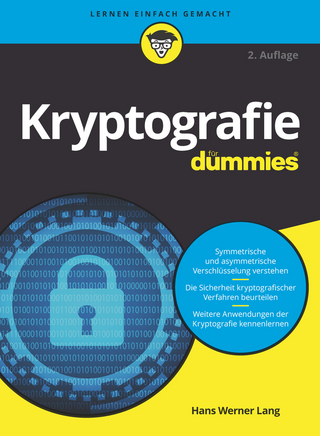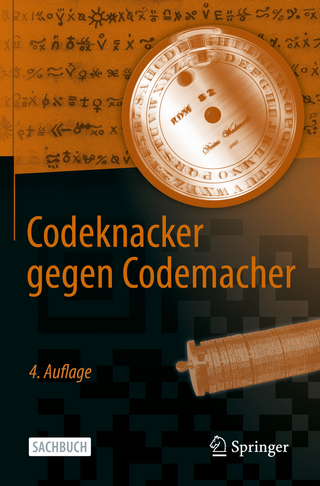
Intelligence and Security Informatics
Springer Berlin (Verlag)
978-3-540-71548-1 (ISBN)
Keynote.- Exploring Extremism and Terrorism on the Web: The Dark Web Project.- Long Papers.- Analyzing and Visualizing Gray Web Forum Structure.- An Empirical Analysis of Online Gaming Crime Characteristics from 2002 to 2004.- Detecting Cyber Security Threats in Weblogs Using Probabilistic Models.- What-if Emergency Management System: A Generalized Voronoi Diagram Approach.- Agent Based Framework for Emergency Rescue and Assistance Planning.- Object Tracking with Self-updating Tracking Window.- A Case-Based Evolutionary Group Decision Support Method for Emergency Response.- Lightweight Anomaly Intrusion Detection in Wireless Sensor Networks.- ASITL: Adaptive Secure Interoperation Using Trust-Level.- A RT0-Based Compliance Checker Model for Automated Trust Negotiation.- TCM-KNN Algorithm for Supervised Network Intrusion Detection.- Research on Hidden Markov Model for System Call Anomaly Detection.- Towards Identifying True Threat from Network Security Data.- Security Assessment for Application Network Services Using Fault Injection.- A Secure Data Transmission Protocol for Mobile Ad Hoc Networks.- Defending DDoS Attacks Using Hidden Markov Models and Cooperative Reinforcement Learning.- A Novel Relational Database Watermarking Algorithm.- Short Papers.- Anticipatory Event Detection for Bursty Events.- Community Detection in Scale-Free Networks Based on Hypergraph Model.- The Treelike Assembly Classifier for Pedestrian Detection.- A Proposed Data Mining Approach for Internet Auction Fraud Detection.- Trends in Computer Crime and Cybercrime Research During the Period 1974-2006: A Bibliometric Approach.- The Study of Government Website Information Disclosure in Taiwan.- Informed Recognition in Software Watermarking.- An Inference Control Algorithm for RDF(S) Repository.- PPIDS: Privacy Preserving Intrusion Detection System.- Evaluating the Disaster Defense Ability of Information Systems.- Airline Safety Evaluation Based on Fuzzy TOPSIS.- A Framework for Proving the Security of Data Transmission Protocols in Sensor Network.- Port and Address Hopping for Active Cyber-Defense.- A Hybrid Model for Worm Simulations in a Large Network.- Posters.- A Web Portal for Terrorism Activities in China.- An Overview of Telemarketing Fraud Problems and Countermeasures in Taiwan.- Mining the Core Member of Terrorist Crime Group Based on Social Network Analysis.- Providing Personalized Services for HWME System by Item-Based Collaborative Filtering.- An Intelligent Agent-Oriented System for Integrating Network Security Devices and Handling Large Amount of Security Events.- Link Analysis-Based Detection of Anomalous Communication Patterns.- Social Modeling and Reasoning for Security Informatics.- Detecting Botnets by Analyzing DNS Traffic.- HMM-Based Approach for Evaluating Risk Propagation.- A Symptom-Based Taxonomy for an Early Detection of Network Attacks.
| Erscheint lt. Verlag | 30.3.2007 |
|---|---|
| Reihe/Serie | Information Systems and Applications, incl. Internet/Web, and HCI | Lecture Notes in Computer Science |
| Zusatzinfo | XII, 332 p. |
| Verlagsort | Berlin |
| Sprache | englisch |
| Maße | 155 x 235 mm |
| Gewicht | 1080 g |
| Themenwelt | Informatik ► Theorie / Studium ► Kryptologie |
| Mathematik / Informatik ► Informatik ► Web / Internet | |
| Schlagworte | Access Control • collaborative computing • computer crime • crime analysis • dark Web • Data Analysis • Data Mining • deception detection • Distributed denial of service • emergency response • Hardcover, Softcover / Informatik, EDV/Internet • HC/Informatik, EDV/Internet • Homeland Security • Information Security • infrastucture security • intelligence informatics • Internet • Intrusion Detection • IT • Monitor • Monitoring • national security • Network Security • privacy • security • security informatics • Surveillance • terrorism informatics • Trust • vulnerability analysis |
| ISBN-10 | 3-540-71548-7 / 3540715487 |
| ISBN-13 | 978-3-540-71548-1 / 9783540715481 |
| Zustand | Neuware |
| Haben Sie eine Frage zum Produkt? |
aus dem Bereich


